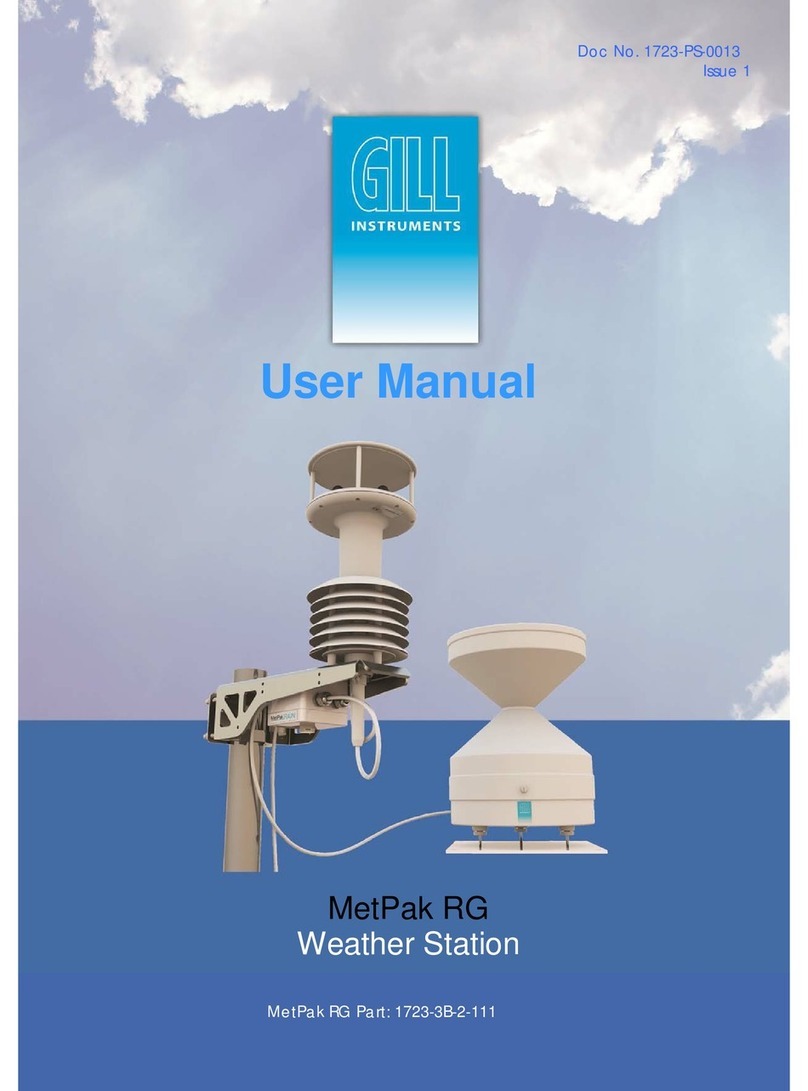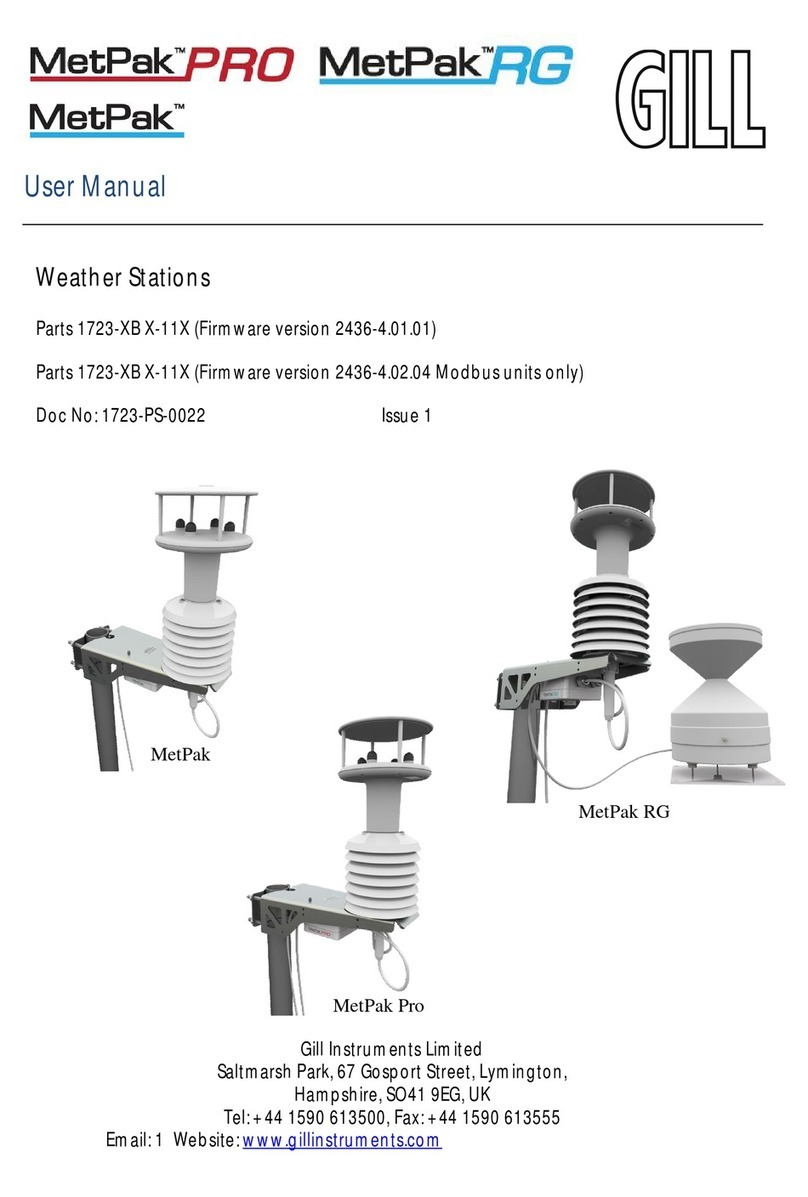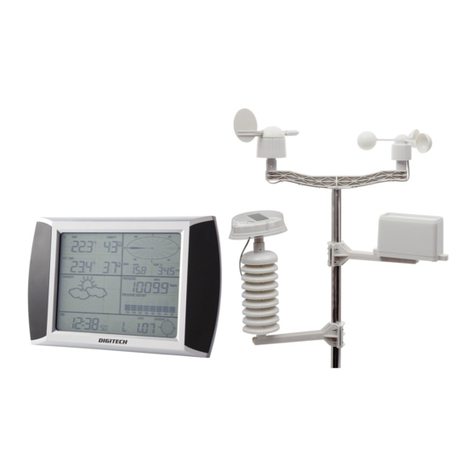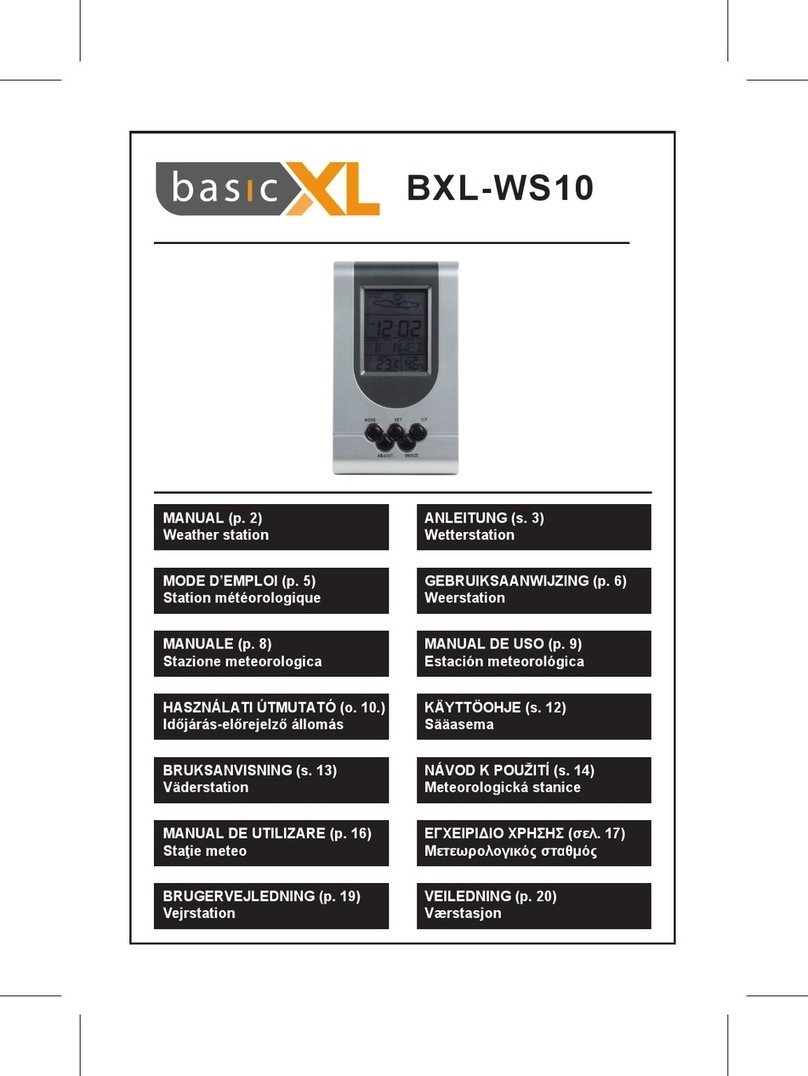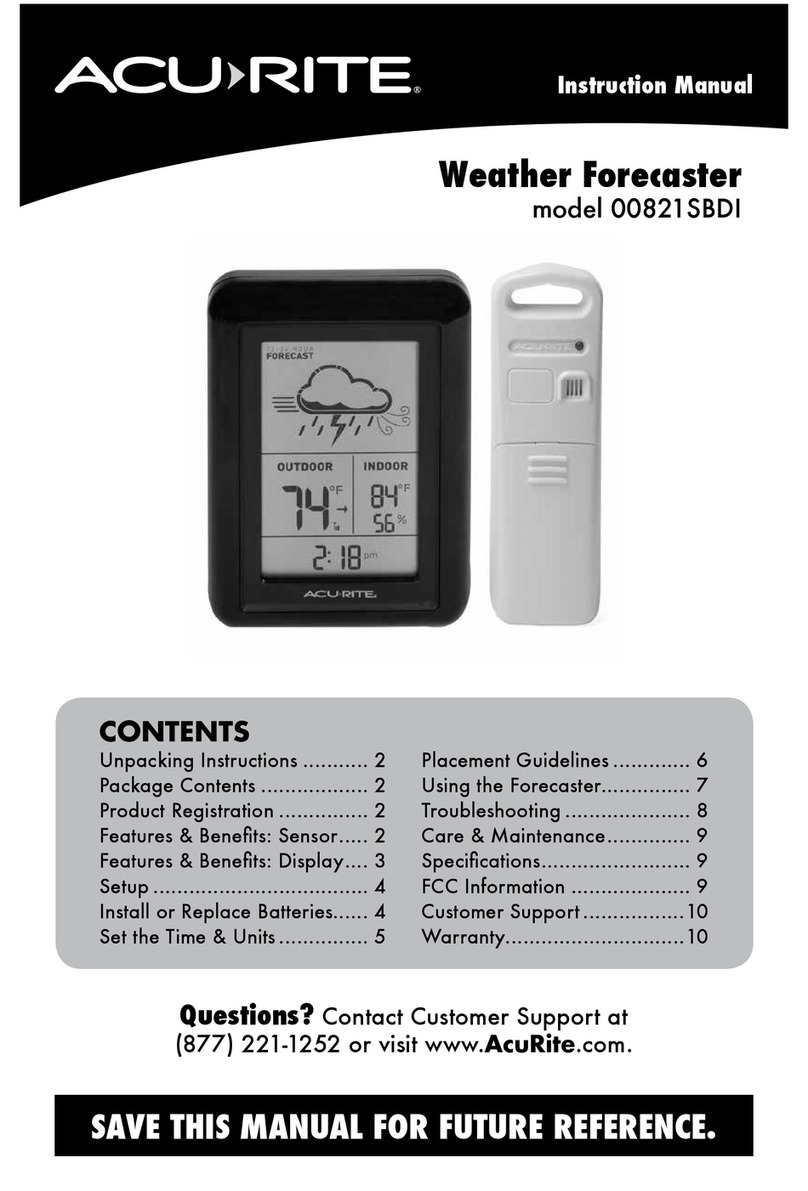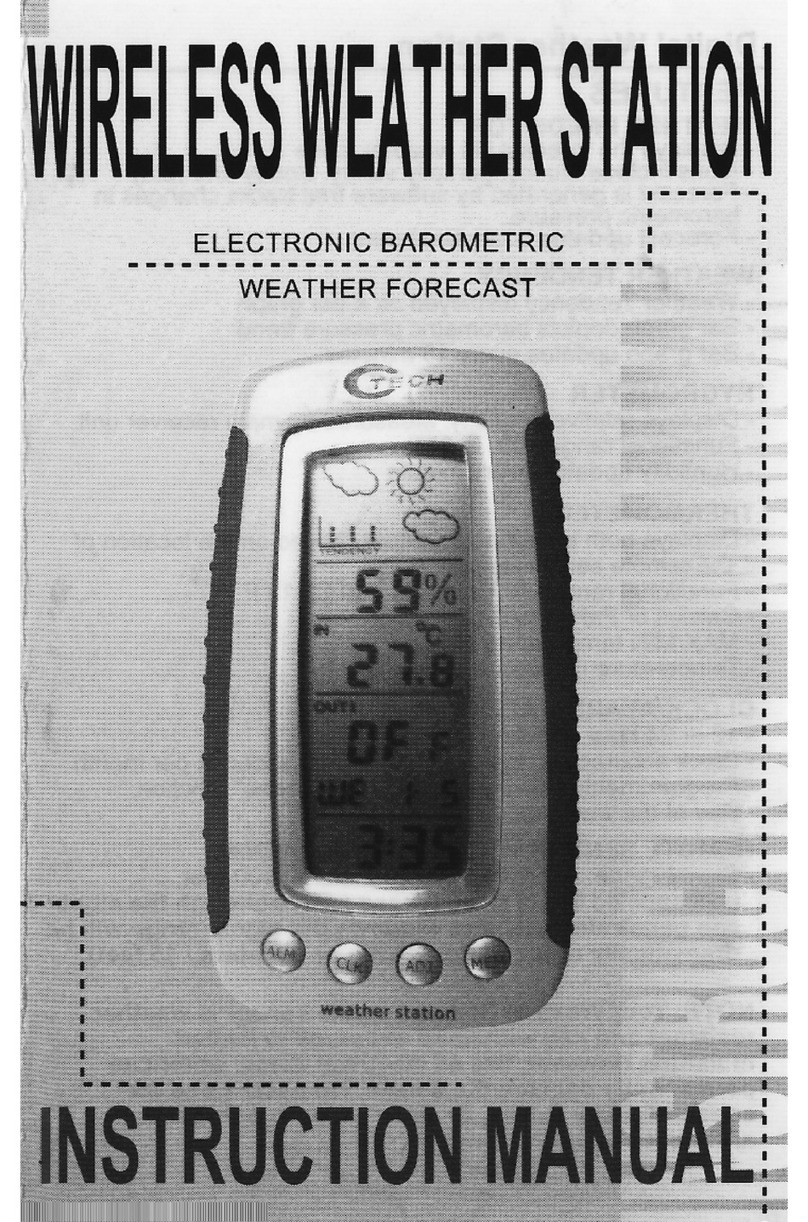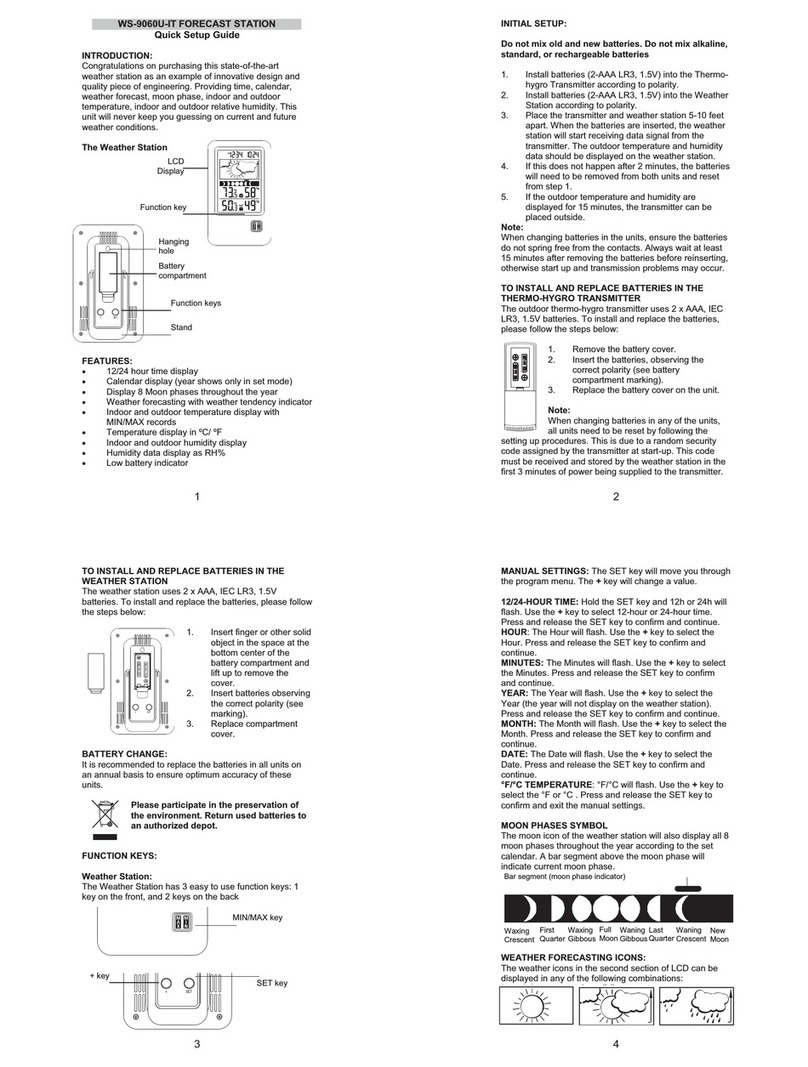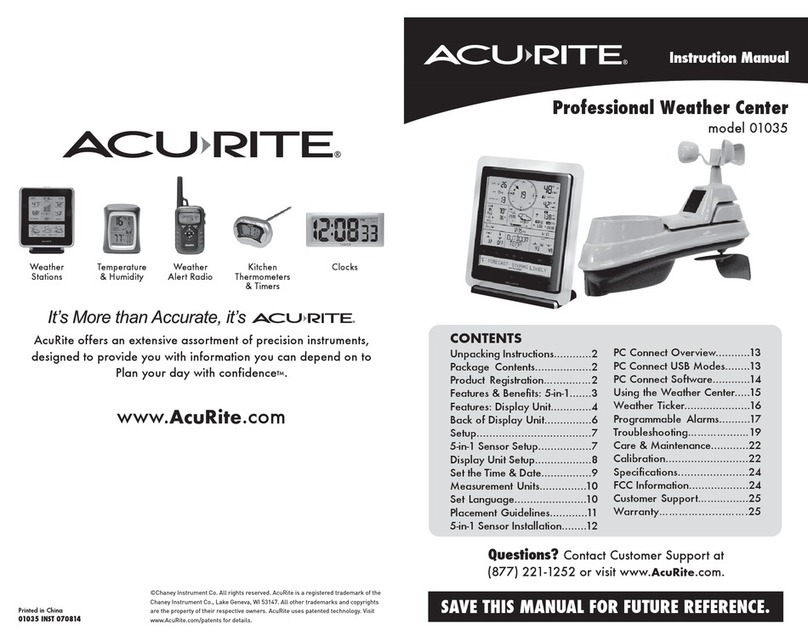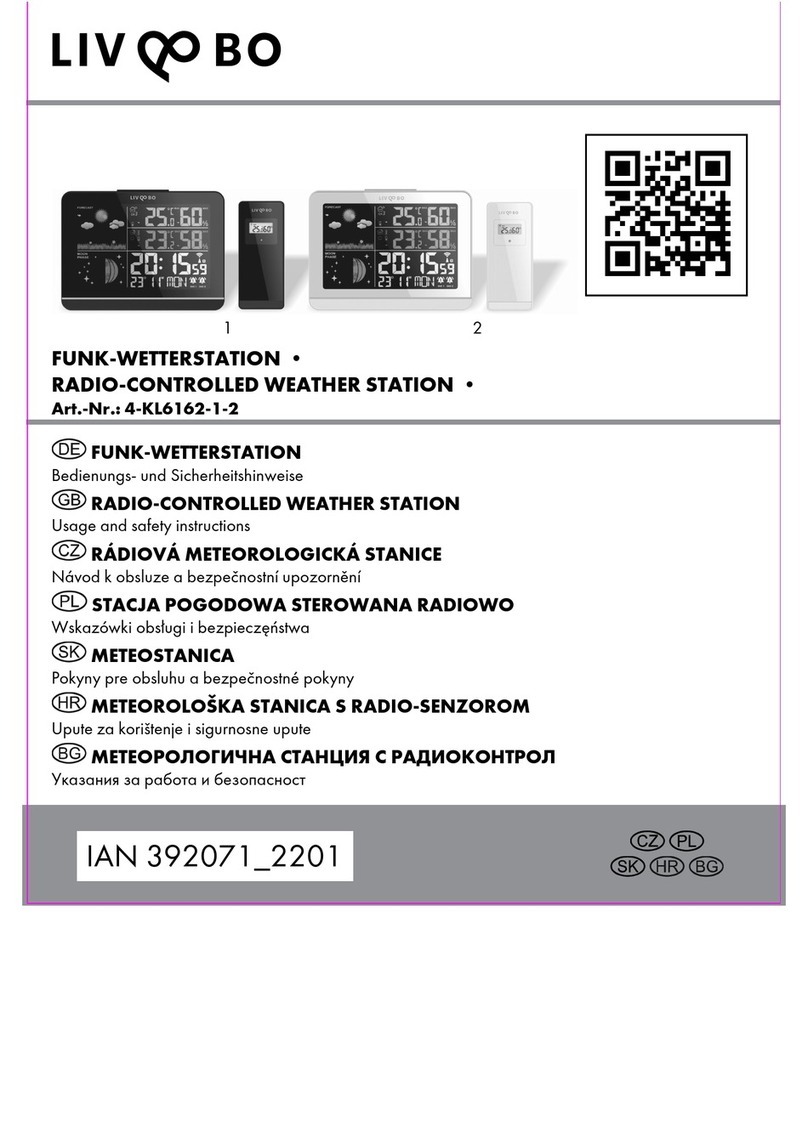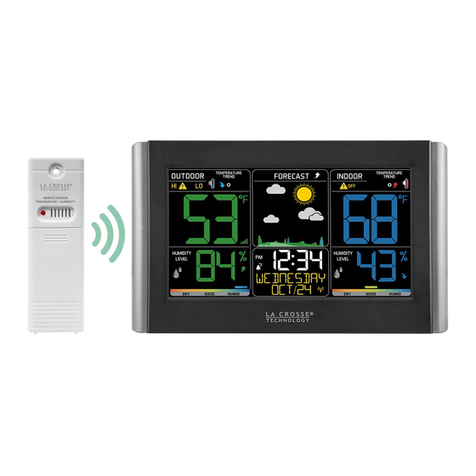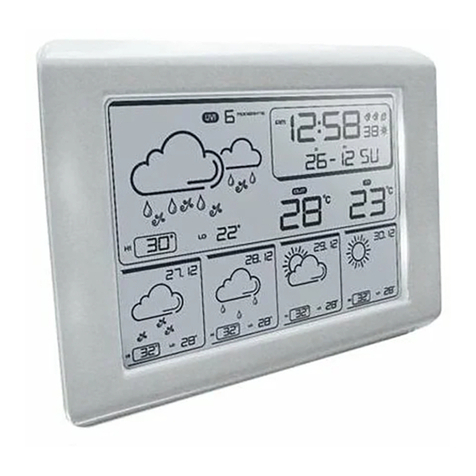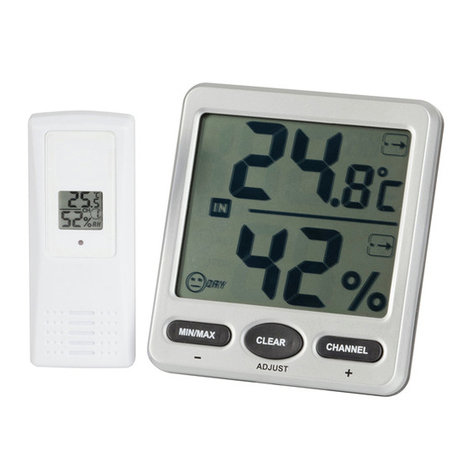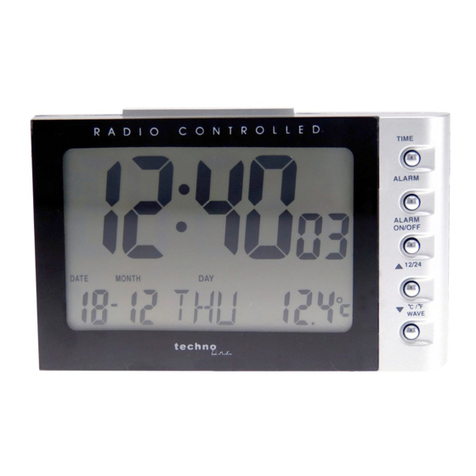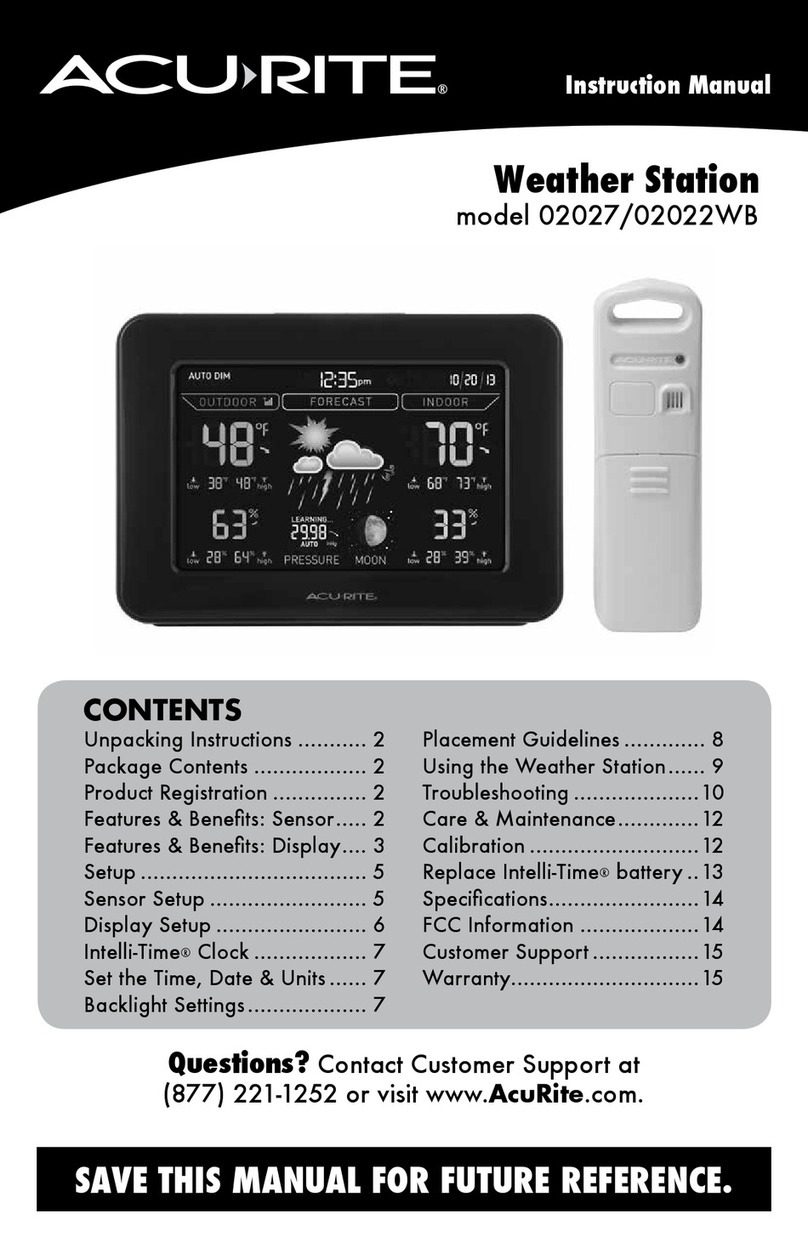Gill Instruments 1723-1A Series User manual

User Manual
MetPak Base Station
Doc No. 1723-PS-0016
Issue 1
MetPak Base Station Part: 1723-1A-X-XXX

Foreword
©2011 Gill Instruments Ltd. All rights reserved.
Thank you for purchasing the MetPak Base Station manufactured by Gill
Instruments Ltd. To achieve optimum performance we recommend that you read
the whole of this manual before proceeding with use.
Gill products are in continuous development and therefore specifications may be
subject to change and design improvements without prior notice.
The information contained in this manual remains the property of Gill Instruments
and should not be copied or reproduced for commercial gain.
Guarantee
For terms of guarantee, please contact your supplier.
Trademarks
Microsoft and Windows are registered trademarks of Microsoft Corporation.
All other brands and product names are trademarks or registered trademarks of
their respective owners.
Cautions and Notes
The following symbols are used in this guide:
CAUTION. This indicates an important operating instruction that should be
followed to avoid any potential damage to hardware or property, loss of data,
or personal injury.
NOTE. This indicates important information to help you make the best use of this
product.
Applicable Parts
MetPak Base Station 1723-1A-1-111 (Base Station only).
MetPak Base Station 1723-1A-2-111 (with White WindSonic Option 2).
MetPak Base Station 1723-1A-3-211 (with HeatedWindSonic M).
MetPak Base Station 1723-1A-4-311 (with HeatedWindObserver 70).
MetPak Base Station 1723-1A-5-111 (with WindMaster).
MetPak Base Station 1723-1A-6-111 (with WindMaster Pro).

MetPak Base Station User Manual
Last Change ©Gill Instruments Ltd
22 April, 2013 Page i
Contents
1. Introduction.........................................................................................................1
1.1 Principle of Operation......................................................................................................2
1.1.1 Wind Speed and Direction Sensor..................................................................... 2
1.1.2 Radiation Shield................................................................................................ 3
1.1.3 Temperature and Relative Humidity Sensor with Dewpoint Output.................... 3
1.1.4 Barometric Pressure.......................................................................................... 3
1.2 Abbreviations.................................................................................................................. 4
2. Installation...........................................................................................................5
2.1 Pre-Installation Checks...................................................................................................5
2.1.1 Spare Parts....................................................................................................... 5
2.2 Installation....................................................................................................................... 6
2.2.1 Bench system test............................................................................................. 6
2.2.2 Bench Test Equipment Required.......................................................................6
2.2.3 Cabling..............................................................................................................7
2.2.4 Communication and Power Connections......................................................... 14
2.2.5 MetPak Base Station System Connections...................................................... 18
2.2.6 Mounting MetPak Base Station ....................................................................... 19
2.2.7 Mounting MetPak Base Station Heater Power Interface Box (Optional Item)... 21
3. Operation...........................................................................................................23
3.1 Start Guide....................................................................................................................23
3.2 MetView........................................................................................................................ 25
3.2.1 Opening MetView............................................................................................ 25
3.2.2 Scanning for Devices....................................................................................... 26
3.2.3 The MetView Console ..................................................................................... 27
3.2.4 MetView Console Display Options................................................................... 29
3.2.5 MetView Gauge Ranges and Graphs.............................................................. 30
3.2.6 Data logging.................................................................................................... 32
3.3 MetPak Base Station Configuration............................................................................... 35
3.4 Configuring MetPak Base Station with MetSet.............................................................. 37
3.4.1 Opening MetSet .............................................................................................. 37
3.4.2 MetSet Editing Screen..................................................................................... 39
3.4.3 Monitoring MetPak Base Station Output Data Using HyperTerminal. .............. 44
3.4.4 Configuring MetPak Base Station for SDI-12...................................................48
3.4.5 SDI-12 Commands.......................................................................................... 48
3.4.6 Safe Mode.......................................................................................................53

Contents
MetPak Base Station User Manual
©Gill Instruments Ltd Last Change
Page ii 22 April, 2013
4. Troubleshooting................................................................................................55
4.1 Fault-Finding.................................................................................................................55
4.2 Servicing....................................................................................................................... 57
4.3 Bench Tests.................................................................................................................. 57
5. Maintenance ......................................................................................................59
6. Technical Information..........................................................................................i
6.1 Specification .................................................................................................................... i
6.2 MetPak Base Station Hub PCB Connections..................................................................iv
6.3 Electrical Conformity Certificate ...................................................................................... v
Figures
Figure 1 U and V Compass points 2 Axis Instruments 2
Figure 2 Position of Temperature and Relative Humidity Probe in the Radiation Shield 3
Figure 3 Internal view of the hub box (top circuit board removed). 14
Figure 4 Connection of Gill USB Cable (Part No. 1723-10-051) 15
Figure 5 RS232 connections 15
Figure 6 RS422 connections 16
Figure 7 RS485 Connections 17
Figure 8 SDI-12 connections 17
Figure 9 MetPak Base Station Example System Pictures 18
Figure 10 Mounting and Dimensions for MetPak Base Station 20
Figure 11 Opening MetView Screen 25
Figure 12 Scanning for MetPak Base Station Devices 26
Figure 13 The MetView Console 27
Figure 14 MetView Gauge Range 30
Figure 15 MetView Graph 31
Figure 16 Setting up data logging 32
Figure 17 Opening MetSet Screen 37
Tables
Table 1 Abbreviations 4
Table 2 Recommended Belden cable types 12
Table 3 Maximum cable lengths for supported communication and sensor network 12
Table 4 Connection status indicators 27
Table 5 MetView scale and unit options 29
Table 6 MetView averaging options 29
Table 7 Max/min markers 29
Table 8 MetView Screen Settings Options 29
Table 9 Default configuration settings 35
Table 10 MetPak Base Station Commands 45
Table 11 Common problems and their solution 55
Table 12 Status codes as output with the MetPak Base Station data string 56
Table 13 HygroClip connections (6-way connector J1) iv
Table 14 Wind Sensor 10 Metre Cable connections (8-way connector J4) iv
Table 15 PC communications (8-way connector, J5) iv

MetPak Base Station User Manual
Last Change ©Gill Instruments Ltd
22 April, 2013 Page 1
1. Introduction
MetPak Base Station is a compact multi-sensor instrument that measures the most
essential weather parameters. It also provides a data collection system that allows
customers to add their own selection of sensors to meet local requirements. A Gill
Instruments Ultrasonic Sensor can be used to measure wind speed and direction.
Temperature and Humidity are measured and Dewpoint calculated using an
industry standard probe housed in a naturally aspirated radiation shield. Barometric
pressure is measured using an industry standard sensor.
The Wind Sensor can be chosen from a 2 axis WindSonic Option 2 (white),
WindSonic M Heated, WindObserver 70 enhanced heated or a 3 axis WindMaster
or WindMaster Pro.
The MetPak Base Station combines all the instrument data into a single combined
data string. This may be configured for digital ASCII RS232/RS422/RS485 (2 wire
point to point) and digital SDI-12 outputs.
The instrument uses a rugged mounting clamp that attaches to any vertical pipe up
from 30mm to 58mm diameter.
The Base Station electrical Hub box comes with a pre-installed 10 Metre cable to
connect to a Gill Wind Sensor. There is one cable gland allocated to provide entry
for termination of other sensors and one cable gland for data/power cables.
A Heater Interface box (optional accessory) allows for termination of the Base
Station 10 Metre cable to a heated Wind Sensor and Heater power supply.
Figure 1 MetPak Base Station
Radiation shield
Temperature and
Relative humidity
sensor
Hub box
Mounting
bracket
Gortex Vent for
Barometric
Pressure Sensor

Introduction
MetPak Base Station User Manual
©Gill Instruments Ltd Last Change
Page 2 22 April, 2013
1.1 Principle of Operation
1.1.1 Wind Speed and Direction Sensor
The MetPak Base Station can be used with Gill 2axis (WindSonic or
WindObserver) or 3 axis (WindMaster or WindMaster Pro) wind speed and
direction sensors. They are connected via the supplied RS422 10 Metre lead. The
sensors measure the times taken for an ultrasonic pulse of sound to travel from the
North transducer to the South transducer, and compares it with the time for a pulse
to travel from S to N transducer. Likewise times are compared between West and
East, and E and W transducer.
If, for example, a North wind is blowing, then the time taken for the pulse to travel
from N to S will be faster than from S to N, whereas the W to E, and E toW times
will be the same. The wind speed and direction can then be calculated from the
differences in the times of flight on each axis. This calculation is independent of
factors such as temperature.
Figure 1 U and V Compass points 2 Axis Instruments
Figure 2 Compass points and polarity of U, V and W on a 3 axis instrument.

Introduction
MetPak Base Station User Manual
Last Change ©Gill Instruments Ltd
22 April, 2013 Page 3
1.1.2 Radiation Shield
The Multi-Plate Radiation Shield protects temperature and relative humidity
sensors from error-producing solar radiation and precipitation. This shield relies on
a combination of plate geometry, material and natural ventilation to provide
effective shielding.
1.1.3 Temperature and Relative Humidity Sensor with
Dewpoint Output
The Rotronic HygroClip module is a complete instrument, with integrated
temperature compensation. Calibration data is maintained within the integrated
electronics. It provides digital output signals for Relative Humidity, Temperature
and Dewpoint to the MetPak Base Station Hub box.
Figure 2 Position of Temperature and Relative Humidity Probe in the Radiation Shield
1.1.4 Barometric Pressure
Barometric pressure output is provided by a solid-state device fitted on to the
circuit board in the MetPak Base Station Hub box. Vent to atmosphere is via a
Gortex filter which also protects the pressure sensor from the effects of wind and
rain.

Introduction
MetPak Base Station User Manual
©Gill Instruments Ltd Last Change
Page 4 22 April, 2013
1.2 Abbreviations
Table 1 Abbreviations
Item
Meaning
ASCII American Standard Code for Information Interchange
C Centigrade
CAL Calibration
CD Compact Disc
COM Communications
CR Carriage Return
CSV Comma Separated Variable
ETX End of String
F Fahrenheit
FPM Feet per Minute
HF High Frequency
HPA Hecto-Pascals
HTML Hyper Text Markup Language
Hz Hertz
IMM International Maritime Mobile
In Hg Inches of Mercury
K Kelvin
KPH Kilometres per Hour
KTS Knots
LF Line Feed
M Bar Milli Bars
Max Maximum
MF Medium Frequency
Min Minimum
Mm Hg Millimetres of Mercury
MPH Miles per Hour
MS Microsoft
MS Metres per Second
NSEW North South East West
NVM Non-Volatile Memory
PC IBM compatible Personal Computer
ROM Read Only Memory
RS232 Communications standard
RS422 Communications standard
Rx Receive
RXD Received Data
SDI-12 Serial – Data Interface standard for microprocessor based
sensors
STX Start of String
Tx Transmit
TXD Transmitted Data
VHF Very High Frequency
WMO World Meteorological Organisation

MetPak Base Station User Manual
Last Change ©Gill Instruments Ltd
22 April, 2013 Page 5
2. Installation
MetPak Base Station has been designed to meet and exceed the stringent
standards listed in its specification (see Para 6.1).
2.1 Pre-Installation Checks
As with any sophisticated electronics, good engineering practice should be followed to
ensure correct operation:
Ensure the MetPak Base Station andWind Sensor will not be affected by other
equipment operating locally, which may not conform to current standards, e.g.
radio/radar transmitters, generators etc.
Avoid mounting in the plane of any radar scanner – a vertical separation of at least
2m should be achieved.
When installing MetPak Base Station and Wind Sensor near radio transmitting
antennas, ensure that the mounting position fulfills the following minimum
separations (all round):
VHF IMM – 1m
MF/HF – 5m
Satcom – 5m (avoid likely lines of sight)
Use cables recommended by Gill (see Para 2.2.3). If cables are cut and re-
connected incorrectly (perhaps in a junction box) then EMC performance may be
compromised if cable screen integrity is not maintained.
Avoid earth loops – wire the system in accordance with these installation
guidelines.
Ensure that the power supply operates to the MetPak Base Station and Wind
Sensor specification (see Para 6.1) at all times.
Avoid turbulence caused by surrounding structures that will affect the accuracy of
the sensors such as trees, masts and buildings. The WMO make the following
recommendations. The standard exposure of wind instruments over level open
terrain is 10m above the ground. Open terrain is defined as an area where the
distance between the sensor and any obstruction is at least 10 times the height of
the obstruction.
Keep away from building exhaust vents, machinery and motors.
2.1.1 Spare Parts
1723-10-051 RS232 to USB 1.8M configuration cable (excluding WindObserver
and WindMaster/Pro connected units).
1723-PK-024 Pressure Sensor Filter Spares kit.
1723-PK-025 Hygroclip Filter Replacement Kit (2 Filters).
1723-PK-099 Heater Power Interface Box.

Installation
MetPak Base Station User Manual
©Gill Instruments Ltd Last Change
Page 6 22 April, 2013
2.2 Installation
2.2.1 Bench system test
Prior to physically mounting the MetPak Base Station in its final location, we
strongly recommend that a bench system test is carried out to confirm the system
is configured correctly, is fully functional and electrically compatible with the
selected host system and cabling (preferably utilising the final cable length). The
required data format, units, output rate, and other options should also all be set up
at this stage.
2.2.2 Bench Test Equipment Required
1723-2A-X-XXX/X MetPak Base Station set for RS232 communication (factory
default setting).
1723-10-051 MetPak Base Station RS232 to USB 1.8M configuration cable with
integral 5v power (for WindSonic units only). Otherwise use RS232
I/F converter and separate 12v to 30 dc power supply.
ES-U-1001-A EasySynch RS232 to USB adaptor or equivalent (if not using Gill
part 1723-10-051) or connect directly to an RS232 COM port.
Power Supply 12Vdc to 30Vdc at 100mA if required.
Belden 9503 3 pair communications and power cable (if not using Gill Part 1723-
10-051), length as required.
Belden cable with up to 6 pairs for Analogue, Digital and PRT inputs.
Gill MetSet Software supplied on the MetPak Base Station CD or download from.
http://www.gill.co.uk/main/software.html
Wind Sensor- should be configured as per the following list:-
1405-PK-072 WindSonic Option 2 White
M4,U1,O1,L1,P1,B4,H2,NQ,F1,E2,T1,S4,C2,G0,K0,
1405-PK-200 WindSonic M Heated
M4,U1,O1,L1,P1,B4,H2,NQ,F1,E2,T1,S4,C2,G0,K0,
1390-70-B-312 WindObserver 70 heated with short connector base.
Note - Firmware Version V 6.02 onwards
M4,U1,O1,L1,P1,B4,H2,NQ,F1,E2,T1,S4,C2,G0,K0,
1590-PK-020 WindMaster
M4,U1,O1,L1,P1,B4,H2,NQ,E1,T1,S1,C2,A4,I1,J1,V1,X1,G0,K0,F1 1,F2 0,F3 1
1561-PK-020 WindMaster Pro
M4,U1,O1,L1,P1,B4,H2,NQ,E1,T1,S1,C2,A4,I1,J1,V1,X1,G0,K0,F1 1,F2 0,F3 1
For Power Supply/Supplies and cables suitable for the chosen Wind sensor see
relevant wind sensor manual supplied with the sensor or download from
http://www.gill.co.uk/data/manuals/manuals.htm .

Installation
MetPak Base Station User Manual
Last Change ©Gill Instruments Ltd
22 April, 2013 Page 7
2.2.3 Cabling
Base Station RS422 10 Metre Cabling
The MetPak Base Station comes with an integral 10 Metre, Belden 8104 cable
fitted to the hub box connector J4, (RS422 interface).
It is terminated in Clipper connector solder contacts for installing into a WindSonic
Option 2 or WindMaster/WindMaster Pro Connector (connectors supplied with the
Wind Sensor).
If used with a WindObserver 70 or WindSonic M the contact pins will need to
be cut off and wire stripped/soldered for termination into the Heater Power
Interface Box.
Details on fitting the connector pins on the 10 Metre cable into the WindSonic
option 2 or WindMaster/WindMaster Pro connector are as follows:-
If shortening the 10 Metre cable to a required length, strip and prepare as follows:-
1. Trim back the screened cable outer PVC sheath to 52mm.
2. Trim back the braid and drain wire to 20mm from the outer sheath.
3. Separate braid and drain wire from the foil and cores. Twist braid and drain
wires together.
4. Trim the twisted braid and drain wire to 15mm from the outer sheath and
tin ends 5mm.
5. Cut the foil and White/Green wire back to within 5mm of the outer sheath.
6. Strip and tin one end of the White/Green wire removed to 5mm.
7. Locate White/Green wire to twisted braid and drain wire and solder.
8. Insulate the White/Green wire joint.
9. Strip back the connection wires by 4mm and tin solder.
10. Solder the contact pins supplied with the connector to the wires.
11. Note that the sensor connector supplies the correct strain relief for cables
with an outside diameter of 6-12mm.
Route the cable through the connector parts as in direction shown below
(WindSonic connector shown, the WindMaster Connector is similar).
Cable Sleeve Contact Pin

Installation
MetPak Base Station User Manual
©Gill Instruments Ltd Last Change
Page 8 22 April, 2013
Whilst squeezing the red retainer in the direction of ARROWS A, pull in the
direction of ARROW B.
A A B
Your connector should now resemble the connector in the picture below.
Insert each contact pin until you feel a slight click. If you have inserted the contact
into the incorrect hole it can be removed at this point by simply pulling it out.
Please note there will be some resistance.
WindSonic (Option 2) RS422 10 Metre Cable Connections
Connections for the WindSonic connector are as follows:-
Green/White wire to Connector Pin 1
1
9
5
3
7
4
2
6
8
Orange/White wire to Connector Pin 2
White/Orange wire to Connector Pin 3
Brown/White wire to Connector Pin 4
White/Brown wire to Connector Pin 5
Rear View of Connector
Blue/White wire to Connector Pin 6
White/Blue wire to Connector Pin 7
White/Green cut off at sleeve

Installation
MetPak Base Station User Manual
Last Change ©Gill Instruments Ltd
22 April, 2013 Page 9
Continue to insert all of the contacts you require. Once all of the contacts are
inserted squeeze the 2 red retainers (See Arrows A on previous page) into place.
NB. The retainer can only be pushed back into place if the contacts are fully
engaged.
Fit the connector to the WindSonic Sensor so that you can finish assembling the
connector.
Screw the back shell onto the connector until it is fully in place. Please note that
the final rotations can be slightly stiff.
Now screw the next part of the connector into place.
Now screw the cable-clamping nut into place.
The connector can now be removed from the WindSonic.
NOTE: To disassemble the connector, reverse this procedure.

Installation
MetPak Base Station User Manual
©Gill Instruments Ltd Last Change
Page 10 22 April, 2013
WindMaster and WindMaster Pro RS422 10 Metre Cable
Connections
The WindMaster uses the same range of connector as the WindSonic except for
being a 31 way type. Follow the WindSonic connector assembly procedure except
for:-
WindMaster 31 way Connector Pin outs
Green/White wire to Connector Pin 4
Orange/White wire to Connector Pin 11
White/Orange wire to Connector Pin 12
Brown/White wire to Connector Pin 2
White/Brown wire to Connector Pin 1
Blue/White wire to Connector Pin 5
White/Blue wire to Connector Pin 6
White/Green wire to Connector Pin 31

Installation
MetPak Base Station User Manual
Last Change ©Gill Instruments Ltd
22 April, 2013 Page 11
WindSonic M (Heated) RS422 10 Metre Cable Connections to
the Heater Power Interface Box.
Note: See also the lid of the Heater Power Interface Box for Connection Details.
Cut off the contact pins connected to the MetPak Base Station 10 Metre cable,
strip and solder wires. Connect wires to the Heater Power Interface box as follows:-
WindObserver 70 (Enhanced Heated) RS422 10 Metre Cable
Connections to the Heater Power Interface Box.
Note: See also the lid of the Heater Power Interface Box for Connection Details.
Cut off the contact pins connected to the MetPak Base Station 10 Metre cable,
strip and solder wires. Connect wires to the Heater Power Interface box as follows:-
Remote Base
Station
Heater Power
Interface Box
WindObserver 70
(Enhanced Heated)
10 Metre Cable 8 Way Terminal Block 19 Way Connector
White/Green 8 or Screen Terminal Tag Cable Screen/Drain wires
Green/White 7 M
Orange/White 6 R
White/Orange 5 D
Brown/White 4 P
White/Brown 3 C
Blue/White 2 U
White/Blue 1 V
No Connection No Connection A, E and H
No Connection No Connection B, F and G
Heater Power
Supply
Heater Power
Interface Box
WindObserver 70
(Enhanced Heated)
4 Way Terminal Block 19 Way Connector
Heater Supply +ve 3 A, E and H
Heater Supply -ve 2 B, F and G
Remote Base Station
Heater Power
Interface Box
WindSonic M
(Heated)
10 Metre Cable 8 Way Terminal Block 9 Way Connector
White/Green 8 1
Green/White 7 No Connection
Orange/White 6 2
White/Orange 5 3
Brown/White 4 4
White/Brown 3 5
Blue/White 2 6
White/Blue 1 7
No Connection No Connection 8
No Connection No Connection 9
Heater Power Supply
Heater Power
Interface Box
WindSonic M
(Heated)
4 Way Terminal Block 9 Way Connector
Heater Supply +ve 3 8
Heater Supply -ve 2 9

Installation
MetPak Base Station User Manual
©Gill Instruments Ltd Last Change
Page 12 22 April, 2013
Remote Base Communication Cabling
MetPak Base Station has five communication connection options:
USB (using the 1.8m Gill USB cable, Part No. 1723-10-051).
RS232
RS422
RS485 (two wire point to point).
SDI-12 (Not with 3 axis WindMaster and WindMaster pro connected)
MetPak Base Station has one external Sensor Input connection:
Gill Wind Sensor via 10 Metre cable (RS422 connection)
It is important that the cable is appropriate for the chosen connection option. The
following sections describe the recommended types and maximum lengths of cable
in each case.
NOTE. A 15-metre, 6-pair cable (wires stripped at each end) suitable for
RS232/RS422 or SDI-12 communication is available from Gill Instruments (Part
No. 1723-10-053).
Cable Type
Wire type: 24AWG
Wire size: 7x32 AWG.
Cable outer diameter: 6-8mm (to match the hub box gland).
For RS422/485 operation the cable should contain twisted pairs screened to match
the application.
The following table shows an example manufacturers’ reference; other
manufacturers’ equivalents can be used.
Table 2 Recommended Belden cable types
Application No. of Pairs Belden Ref.
SDI-12 or RS485 2 9729
Digital RS232 3 9503
Digital RS422 4 9504
Multiple External Sensors 6 9506
Cable length
The maximum cable length is dependent on the chosen communication method.
The following table shows the maximum cable lengths for the supported
communication protocols at the given baud rates, using the recommended cable. If
any problems of data corruption etc. are experienced, then a slower baud rate
should be used. Alternatively, a higher specification cable can be tried.
Table 3 Maximum cable lengths for supported communication and sensor network
Communication format Baud rate Max. cable length
RS232 19200 6.5M
RS422/485 19200 1000M
SDI-12 1200 90M

Installation
MetPak Base Station User Manual
Last Change ©Gill Instruments Ltd
22 April, 2013 Page 13
Cabling (unused wires)
Any unused wires in the connecting cables should be connected to ground
preferably at the user equipment end.
Cabling protection
The Cable should be secured:
With cable clamps or equivalent at regular intervals such that the hub
box cable gland does not support the cable weight.
Away from the mounting bolts to prevent chaffing of the cable.
NOTE. Install appropriate strain relief support to the cable. If possible, pass the
cable through the mounting pole.
Earthing
To ensure correct operation and for maximum protection from lightning, a separate
lightning rod system is recommended to protect the system.
You can also earth the MetPak Base Station through its mountings or by
connecting a grounding cable (minimum of 6mm² copper wire) to a spare MetPak
Base Station metalwork bolt hole. Clean off any paint that might prevent a good
connection on the installation.
When you connect the communications cable ensure that the screen has a
connection to the hub box case.
The Junction Box accessory and Heater Power Interface Box have a plastic case,
hence ensure continuity of cable screens into and out of the boxes using the
common earthing terminals provided in the boxes.
Routing Cables through the Hub Box Glands
NOTE: The MetPak Base Station Hub Box cable glands contain spring loaded
metal leaves that are designed to make a ground contact with cables that have an
overall braid screen. Care is therefore required when inserting and removing
cables through the glands to prevent damage to the metal leaves.

Installation
MetPak Base Station User Manual
©Gill Instruments Ltd Last Change
Page 14 22 April, 2013
2.2.4 Communication and Power Connections
To connect the MetPak Base Station Power and Communications cable:
1. Open MetPak Base Station’s hub box by unfastening the four screws.
2. Locate connector J5 (see Figure 3). Carefully pull the connector off its circuit
board pins.
3. Strip the cable wires to 8mm.
4. Pass the cable through one of the gland nuts (please refer to the 2nd NOTE
on Page 8).
5. Connect your cable as shown in the following diagrams:
Gill USB Cable Figure 4
RS232 Figure 5
RS422 Figure 6
RS485 Figure 7
SDI-12 Figure 8
6. Attach the cable’s screen wires to the terminal post (see Figure 3).
7. After connection, securely tighten the gland nut to prevent moisture ingress.
NOTE. Ensure that MetPak Base Station is configured for the chosen
communications method
Figure 3 Internal view of the hub box (top circuit board removed).
J4 Pin 8 J5 Pin 8 J5 Pin 1 Hex Terminal
Post
J1 Pin 6 J5, showing RS232 to USB
Configuration Cable Wires
J4 Pin 1

Installation
MetPak Base Station User Manual
Last Change ©Gill Instruments Ltd
22 April, 2013 Page 15
USB Lead Connection (COMMS set for RS232)
Connect MetPak Base Station to a PC USB port using the Gill Configuration Cable 1723-10-051.
J5 Pin 1 2 3 4 5 6 7 8
Colour None None Yellow Orange None None Black Red
Figure 4 Connection of Gill USB Cable (Part No. 1723-10-051)
This USB cable can supply the necessary minimum 5v power for configuring a
Base Station hub box and with a WindSonic/WindSonic M unit connected to the 10
Metre cable.
This USB cable cannot be used to power the Base Station with a WindObserver 70
or WindMaster/WindMaster Pro connected to the 10 Metre cable.
NOTE:- If upon connecting the USB lead to a PC the driver is not found by the PC, then
the appropriate driver to match the PC Windows version may be downloaded from:-
http://www.ftdichip.com/Drivers/VCP.htm
NOTE. Ensure that MetPak Base Station 10 Metre cable is terminated before
connecting the USB cable as sensor power is connected to the 10 Metre
cable pins.
Digital Output RS232 Connections (COMMS set for RS232)
This is the MetPak Base Station default communication configuration setting.
J5 Hub Box
8 Way Push fit Block PC 9 Way D Type
Connector
Signal names Terminal
Nos. 3 Pair Cable Pin
No’s Signal
Names
RS232 TX
RS232 RX 3
4 2
3 RXD
TXD
Signal Ground 2 5 Sig Gnd
Chasis Ground Terminal
Post Screen wires
NA Chassis
Ground
Supply –ve
Supply +ve 7
8 –
+ DC Power
supply
NOTE. Ensure that MetPak Base Station 10 Metre cable is terminated before connecting dc
power as sensor power is connected to the 10 Metre cable
Figure 5 RS232 connections
Connect to
Hub box J5

Installation
MetPak Base Station User Manual
©Gill Instruments Ltd Last Change
Page 16 22 April, 2013
Digital Output RS422 Connections (COMMS set for RS422)
This is not the default communications setting; ensure the MetPak Base Station
has been configured for this output requirement before wiring to a user device.
J5 Hub Box
8 Way Push fit Block RS422 to RS232 or
USB Converter
Signal Names Terminal
Nos. 4 Pair Cable Signal Names
RS422 TX +
RS422 TX – 6
3 RX +
RX –
RS422 RX +
RS422 RX – 5
4 TX +
TX –
Signal Ground 2 Signal Ground
Chassis
Ground Terminal
Post Screen wires
Chassis Ground
Supply –ve
Supply +ve 7
8 –
+ DC Power Supply
NOTE. Ensure that MetPak Base Station 10 Metre cable is terminated before connecting the
DC power supply as sensor power is connected to the 10 Metre cable.
Figure 6 RS422 connections
Digital Output RS485S 2 Wire Point to Point Connections
(COMMS set for RS485P2W)
This is not the default communications setting; ensure the MetPak Base Station
has been configured for this output requirement before wiring to a user device.
Note that it is not possible to network other devices on this 2-wire RS485
link.
J5 Hub Box
8 Way Push fit Block RS485 to RS232
or USB Converter
Signal Names Terminal
Nos. 2 Pair Cable Signal Names
RS485 TX +
RS485 RX+ 6
5 RS485TX/RX+
RS485 TX –
RS485 RX – 3
4 RS485TX/RX–
Signal Ground 2 Signal Ground
Chassis
Ground Terminal
Post Screen wires
Chassis ground
Supply -ve
Supply +ve 7
8 –
+ DC Power
Supply
NOTE. Ensure that MetPak Base Station 10 Metre cable is terminated before connecting the
DC power supply as sensor power is connected to the 10 Metre cable.
This manual suits for next models
1
Table of contents
Other Gill Instruments Weather Station manuals
